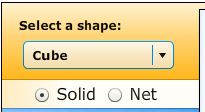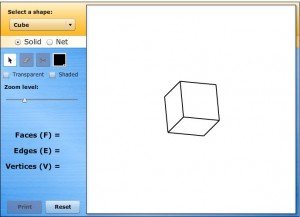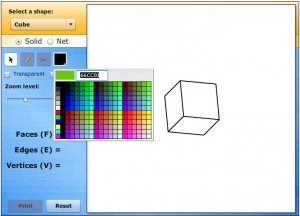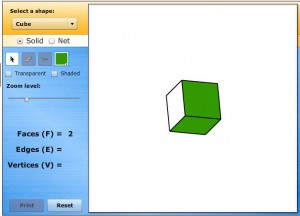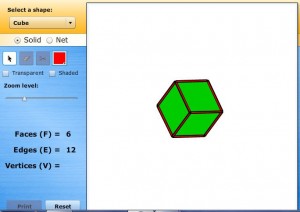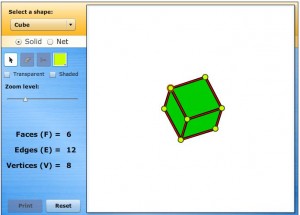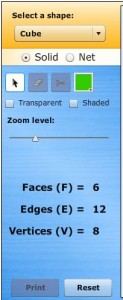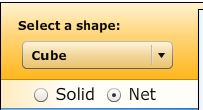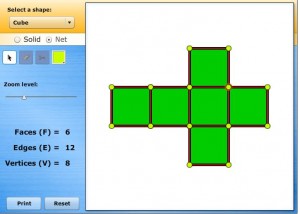Exploring the concept of the properties of solids, faces, edges and vertices. Illuminations
Students in grade 3 have great difficulty understanding this concept and find it difficult to manipulate concrete solids without getting confused and counting the property more than once. With this simulation they can easily manipulate the solid and using color keep track of what they are counting.
Students should note the following characteristics:
- Each solid has flat sides called faces.
- Each solid has edges to connect the faces.
- Each solid has vertices that connect the edges.
1. Choose a solid: click on the drop down box to choose your solid
2. Manipulate the solid in the workspace. Click and drag the shape to move to rotate it. Use the tools to explore the properties.
3. Explore the tools
Select: Adds faces from the bank on the left and moves pieces.
Eraser: Erases individual faces.
Scissors: Cuts pieces at edges.
![]() Zoom in and out by sliding the marker
Zoom in and out by sliding the marker
![]() Prints nets directly to the printer
Prints nets directly to the printer
4. Select a different color to color in faces, edges, and vertices. Click on elements to color them.
Faces are the flat surfaces Click on the flat surfaces.
Edges: where 2 flat surfaces meet. Click on the edges
Vertices: where 2 edges meet. Click on the vertices.
5. As elements are colored, they are counted in the left panel.
How many faces, edges and vertices does a cube have?
Record your findings on your recording sheet
6. Click on Net
7. Watch your solid unfold. What are the shapes of the faces in your solid?
8. Click print to print your net
9. Click on solid and watch the net fold to form your solid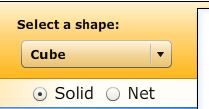
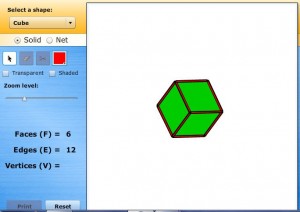
10. Cut out and fold your net
11. Click Select a Shape: My Own Net
Create your own net, and then print, cut, and fold to see if it forms a solid.
12.Choose another solid: click on the drop down box to choose your solid. Repeat steps 3 – 10 for each solid.
13. Answer the questions 1 – 3 on the recording sheet, share your results with your shoulder partner.
Knowledge Representation and Info-vis
Why is visualization necessary (or not) for student understanding of math or science?
For the examination of knowledge representation and info-vis I explored Illuminations. I have used Illuminations in my classroom as a whole group activity on the smartBoard to introduce the concept of faces, edges and vertices and in the lab with students on individual computers to explore the concepts and make connections. The software is student friendly and easy to navigate after the initial introduction by the teacher. The explorations are engaging and motivate students to continue the activity.
A study by Finkelstein et al. (2005) examined the effects of computer simulations on student understanding of electrical circuits. According to the authors, simulations enhanced student learning due to:
- ready access to necessary tools, the group using the equipment wasted time looking for light bulbs and different coloured wires;
- ease of use because the other group had difficulty telling if the dim bulbs were lit or not.
Based on my own experience with grade 3 students and the information shared by my peers in the Resource Share forum students have great difficulty visualizing abstract concepts in Math and Science. Simulations and images help improve students’ understanding of complex concepts by making them visible. According to Finkelstein et al. (2005) “… visual cues in computer simulations make concepts visible that are otherwise invisible to students” (p. 6).
In teaching the properties of geometric solids to grade 3 students I have observed that students have great difficulty understanding and using the properties to describe a solid. The use of concrete manipulatives is not enough for some students to help them grasp the concepts. Students experience difficulty counting the edges, vertices and faces and for some the manipulatives become a building toy. In the Resource Share forum D.F. stated “As students develop the ability to analyze data they need be not be hindered by their fine motor skill development and limited abilities to create graphs with accurate proportion. A resource such as this ensures that the students are able to concentrate on the math and the concepts.” Although she was referring to graphing it can be applied to other mathematical or science concepts. Simulations enable my students to manipulate the solids, color a particular property and focus them on the concept being studied. Observers noted in Finkelstein’s et al. (2005) study “that the messing about was more generally restricted to building circuits” (p. 5). I have found that students using the simulations with solids do play around however the play is directly related to solid properties as they explore faces, edges and vertices of other solids. Also the inclusion of a recording sheet with reflective questions further deepen student understanding of concepts and foster student accountability.
In the discussion, Finkelstein et al. identified other possible advantages of using simulations, student engagement; simulations highlight the important points of an activity with cues and the inclusion of student reflection activities that promote deep meaningful learning.
In my search for resources to share it became readily obvious that not all simulations are equal. Like any other resource or strategy used, in the classroom, simulations need to be ‘properly designed’ and applied to ‘the right context’ (p. 1).
Reference:
Finkelstein, N.D., Perkins, K.K., Adams, W., Kohl, P., & Podolefsky, N. (2005). When learning about the real world is better done virtually: A study of substituting computer simulations for laboratory equipment. Physics Education Research,1(1), 1-8.
http://illuminations.nctm.org/ActivityDetail.aspx?ID=70
Resource Share Forum. Create a graph It starts somewhere. https://www.vista.ubc.ca/webct/urw/tp8292565616151.lc8292565591151/newMessageThread.dowebct?discussionaction=viewMessage&messageid=8895291953291&topicid=8292565804151&refreshPage=false&sourcePage=

